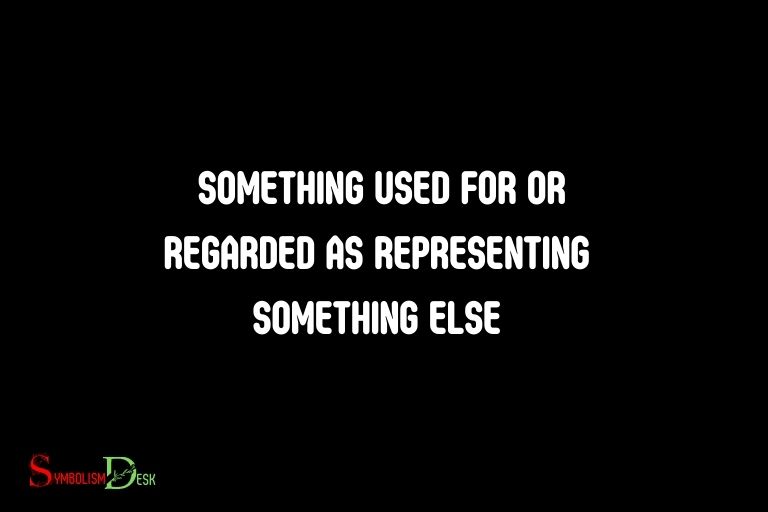What Does Symbol Mean in a Sentence? With Chart!
In a sentence, a symbol is a character or a graphic element that represents an idea, concept, or object without the use of words.
Symbols are powerful communication tools because they convey complex ideas or emotions in a simple and easily recognizable form.
In writing, symbols can be used to enhance the meaning of a sentence or to evoke emotions in the reader.
Symbols can be letters, numbers, punctuation marks, emojis, and other visual elements that have a specific meaning.
Symbols are a significant aspect of language and communication as they allow for the expression of complex ideas using easily recognizable and concise representations.
In a sentence, symbols can help to evoke emotion, emphasize a point, or even replace words altogether.
By understanding the meaning of various symbols, we can better comprehend the underlying message and intention of the author.
Interpretations of Different Symbols in Sentences
| Symbol | Meaning in a Sentence |
|---|---|
| . | Indicates the end of a sentence or a statement. |
| , | Used to separate items in a list or to indicate a pause in a sentence. |
| ; | Separates closely related independent clauses or items in a series that contains commas. |
| : | Introduces a list, an example, or an explanation. |
| ? | Indicates the end of a question. |
| ! | Conveys excitement, surprise, or emphasis at the end of a sentence. |
| – | Connects words or parts of words (hyphen); sets off a parenthetical element (en dash); indicates a range (en dash) or separates thoughts (em dash). |
| ( ) | Encloses additional or explanatory information within a sentence. |
| [ ] | Indicates added information within a direct quote or a clarification within a sentence. |
| ” “ | Indicates a direct quotation from a source. |
| ‘ ‘ | Marks a quote within a quote or an attribution to the source. |
| & | Represents the word “and” when connecting two words or phrases. |
| * | Used to emphasize a word or indicate a footnote. |
| / | Separates alternatives, as in “and/or”, or indicates the end of a line in a poem. |
| @ | Refers to someone on social media or can be used in place of the word “at”. |
| # | Represents a topic or keyword in social media (hashtag). |
| % | Indicates a percentage within a sentence. |
Key Takeaway

Five Facts About: Symbols in Sentences
What Are Symbols And Why Are They Important In Writing?
Definition Of Symbols In Writing
Symbols are characters or images used to represent abstract ideas, concepts, or actions. They are used to convey meaning in a more concise and engaging way.
Symbols in writing are used to add depth and layers to written work.
Examples Of Symbols In Sentences
There are numerous examples of symbols in sentences that you might encounter,
some of which include:
- ‘the dove is a symbol of peace.’
- ‘the red rose is a symbol of love.’
- ‘the white flag is a symbol of surrender.’
These sentences use symbols to communicate a particular meaning in a concise and impactful way, enabling the reader to grasp the message quickly.
The Role Of Symbols In Conveying Emotions And Ideas
Symbols play a significant role in conveying emotions and ideas in writing. They can be used to evoke or represent a particular mood, feeling, or emotion.
They can also be used to emphasize an idea or concept.
Some common ways symbols are used include:
- In literature, symbols are used to enrich the narrative and give it depth.
- In advertising, symbols are used to create brand recognition and communicate the brand’s values and principles.
- In graphic design, symbols are used to create a visual language that audiences can easily understand.
Symbols are essential in writing because they can convey complex ideas and emotions in a concise and impactful way.
They enable the reader to connect with the message on a deeper level and engage with the content in a meaningful way.
Different Types Of Symbols And How They Work
Symbols can be used in many ways in a sentence. They help writers express certain emotions, add emphasis, and provide additional meaning.
There are different types of symbols, and each of them functions differently.
Punctuation Marks As Symbols In Sentences:
Punctuation marks are widely used as symbols in sentences. They help indicate how the text should be read, where the emphasis should be placed, and where pauses should occur.
Here are a few examples of punctuation marks used as symbols:
- Exclamation mark: It expresses strong emotions such as excitement, surprise, or anger. Example: “i can’t believe we won!”
- Ellipsis: It indicates that something has been omitted or left unsaid. Example: “i don’t know… It just doesn’t feel right.”
- Parentheses: It adds extra information that is not necessary for understanding the sentence. Example: “the party (which was held last week) was a disaster.”
Icons And Images As Symbols In Sentences:
Icons and images add visual meaning to a sentence. They are used to make the text more attractive and understandable.
Some of the most commonly used icons and images include:
- Emoji: It is a small digital image or icon used to express an idea or emotion. Example: “i’m feeling so happy 😊 today!”
- Arrows: They are used to indicate direction or movement. Example: “please turn ➡️ right at the traffic light.”
- Checkmark: It is used to indicate that something is correct or has been completed. Example: “i have finished my assignment ✔️.”
Various Other Examples Of Symbols In Sentences:
Apart from punctuation marks, icons, and images, there are several other examples of symbols used in sentences.
Here are a few:
- Currency symbols: $, €, £, ¥, etc., are used to denote different types of currency. Example: “i spent $50 on groceries today.”
- Mathematical symbols: +, -, ×, ÷, =, etc., are used to solve mathematical problems. Example: “5 + 3 = 8.”
- Trademark symbols: ™, ©, ®, etc., are used to indicate ownership or trademark status. Example: “all rights reserved ©.”
Symbols play a significant role in making sentences more engaging and meaningful.
Understanding how different types of symbols function can help writers use them more effectively. So, the next time you see a symbol in a sentence, pay attention to how it adds meaning and impact.
The Influence Of Symbols In Language
What Does Symbol Mean In A Sentence?
Symbols are objects, images, words, or phrases that represent something else beyond their literal meaning. Symbols are often used in literature, art, and everyday life to convey deeper meanings or evoke certain emotions. The symbolism meaning in English language lies in its ability to connect abstract ideas with tangible representations, allowing complex concepts to be communicated more effectively. By understanding the context and cultural associations, one can uncover the layers of significance behind a symbol.
They play a crucial role in language as they help to convey complex ideas or concepts in a simple and concise manner.
Symbols can evoke strong emotions and influence how we perceive the message conveyed in a sentence.
This blog post examines the influence of symbols in language and why it is important to understand them.
Cultural Significance Of Symbols
Symbols are culturally significant and have different meanings in different societies. For instance, in western cultures, the color black often signifies mourning, grief, or death.
However, in some african cultures, the color white represents mourning.
Therefore, understanding the cultural significance of symbols is important in communicating effectively with people from diverse backgrounds.
Bullet points:
- Symbols have cultural significance and meaning.
- Different cultures may interpret symbols differently.
- Understanding cultural symbols can help in effective communication with diverse audiences.
The Importance Of Understanding Symbols In Interpretation
Understanding symbols is essential in interpreting the meaning of a sentence. Symbols can add layers of meaning and evoke an emotional response to a sentence.
For example, the use of a red rose in a sentence may evoke feelings of love, passion, or desire.
An understanding of symbols helps to avoid misinterpretation of sentences.
Bullet points:
- Symbols can add layers of meaning to a sentence.
- Understanding symbols helps to avoid misinterpretation.
- Sentences with symbols can evoke an emotional response.
How To Use Symbols Effectively In Your Writing
To use symbols effectively in your writing, one must consider the audience and the context in which they are being used.
Symbols should support the meaning of a sentence and not distract from it. Use of common symbols or symbols that have common cultural significance can improve the clarity and effectiveness of your content.
Bullet points:
- Consider the audience and context when using symbols.
- Symbols should support the meaning of a sentence.
- Use common symbols or symbols with common cultural significance.
Understanding the influence of symbols in language is crucial in effective communication. An awareness of culturally significant symbols can aid communication with diverse audiences.
Use of symbols can add layers of meaning and evoke an emotional response in sentences. To use symbols effectively, one needs to consider the audience and context in which they are being used.
Challenges Faced When Using Symbols In Sentences
When we write, we often use symbols to express ourselves more concisely. Even though their use can save time, it can also lead to misinterpretation.
Below are some of the challenges faced when writing sentences using symbols.
Common Symbolic Misunderstandings And Mistakes
- Overuse of symbols: Some writers overuse symbols, which can cause confusion and misinterpretation. It’s essential to ensure that symbols are used only when necessary, and their meaning is clear to the reader.
- Lack of context: Symbols often require context to be understood correctly. If a symbol is used without proper context, it can be confusing and cause misunderstandings.
- Multiple meanings: Some symbols have multiple meanings, and writers need to ensure that the meaning is clear in the context of the sentence. Otherwise, the readers may misunderstand the intended message.
Preventing Conflicts And Misinterpretation In Writing
When we use symbols in our sentences, we need to ensure that they don’t cause conflicts or misinterpretation.
Below are some tips to help prevent these issues.
- Clearly define symbols: When using a symbol in a sentence, ensure that its meaning is explicitly defined to avoid misunderstandings.
- Use easy-to-understand symbols: Use symbols that are easy to understand and widely used to prevent confusion.
- Provide adequate context: Always provide enough context to help the reader understand the meaning of the symbol.
When To Avoid The Use Of Symbols In Sentences
Finally, it’s essential to know when to avoid the use of symbols in sentences to prevent misinterpretation or confusion.
- Lack of clarity: If the sentence’s meaning is unclear, using symbols can further complicate it. It’s better to use clear language that is easy to understand.
- Formal writing: In formal writing, symbols should be used sparingly or avoided entirely.
- Potential for misinterpretation: If there is a risk of misinterpreting the symbol’s meaning, it’s better to avoid its use.
Symbols are excellent tools for conveying meaning concisely, but it’s essential to use them correctly to prevent misinterpretation.
By following these guidelines, you’ll be able to use symbols in your writing effectively and avoid potential conflicts.
What Does the Symbol Mean in SQL and in a Sentence?
In SQL, the symbol meaning in sql operation is crucial for query execution. For instance, the equals symbol (=) is used to match values, while the not equal to symbol (!=) signifies inequality. These symbols play a pivotal role in constructing accurate SQL statements and retrieving desired results from databases.
FAQ About What Does Symbol Mean In A Sentence
What Is The Meaning Of Symbol In A Sentence?
In a sentence, a symbol is a character or group of characters representing something else.
What Are Some Common Symbols Used In Sentences?
Common symbols used in sentences include punctuation marks, mathematical symbols, and currency symbols.
How Do Symbols Add Meaning To A Sentence?
Symbols add meaning to a sentence by providing a visual representation or shortcut for a word or phrase.
How Are Symbols Different From Words In A Sentence?
Symbols are different from words in a sentence because they are a visual representation rather than a linguistic one.
Can Symbols Change The Tone Of A Sentence?
Yes, symbols can change the tone of a sentence by adding emphasis, conveying emotion, or indicating sarcasm.
Conclusion
Symbols are an essential part of any language, and understanding their meaning is crucial for effective communication.
Whether it’s a punctuation mark or an emoji, every symbol represents something unique and significant.
We understood that symbols can change the entire meaning of a sentence, and using them correctly is essential. While using symbols, it’s crucial to be considerate of the context, tone, and audience.
Additionally, we discussed how to use symbols effectively to make our writing more concise and engaging.
As content writers, knowing the meaning of symbols is beneficial because it allows us to communicate better with our audience and make our content more effective.
So, the next time you see a symbol in a sentence, remember its significance and use it wisely.






